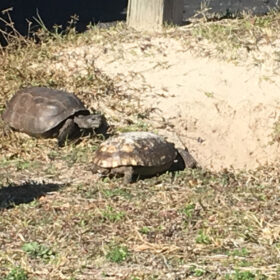By Pat Foster-Turley
September 9, 2022

Many people who live here on Amelia Island are familiar with gopher tortoises, or should be, anyway. These iconic reptiles inhabit our oceanfront sand dunes, the coastal strand vegetation behind it and any sandy sunny spots elsewhere where they can find the berries, fruits, leaves and the other vegetation they feed on, and the deep sand they need to dig their burrows in. Gopher tortoises dig burrows up to 40 feet long and share these lodgings with scores of other native species, including raccoons, opossums, snakes, rodents, insects and frogs. They are considered a “keystone species” since their burrows provide shade and shelter from the hot sun for all of these associated species and are also a good place to retreat to in times of fire.
Under the best of circumstances, tortoises can live in the wild for up to 60 years. During this time they become attuned to the seasonal cycles of prickly pears, smilax berries and the other fruits and plants in their home territories that they feed on. They also remember the location of their tortoise neighbors during mating season. If they are lucky, their food plants are still around nearby to forage on and their mates are on the same side of the roads. But as more buildings and roads clutter the landscape, fewer tracts of native vegetation remain and increasing traffic stands in their way to find these resources.
Gopher tortoises seem oblivious to the passing vehicles in their single-minded determination to cross the road. And however hard their shell is, it isn’t hard enough to withstand being run over. Some don’t make the crossing and dead gopher tortoises are occasionally seen along our roadways. It is always heartbreaking to see an animal that has lived here for decades in a flattened, lifeless heap. It is no surprise that, in Florida, gopher tortoises are a “threatened species.”

South Fletcher Avenue is a particular deathtrap these days for gopher tortoises, but those of us who have lived here for years know the drill. When a gopher tortoise is spotted on the road, the best course of action is to stop your car and protect its crossing. Problems arise though when cars coming the other way don’t see why you are stopping. In this case I usually open my window and catch the driver’s attention before it’s too late. If there is no traffic to endanger me, I’ll stop and move the tortoise across the road in the direction it is heading. The tortoise knows where it wants to go and will keep moving in that direction after the helping hand. There is no sense in putting a determined tortoise back on the “safe” side of the road. In its reptilian mind, it is heading for a place it knows and has always gone to, cars be damned.
People living along South Fletcher are also doing their best to alert drivers to the presence of tortoises crossing the road, and a number of them have placed signs in this regard on their lawns. Some homeowners have watched the same tortoises cross the road in front of their house for years on end and wish to protect them. But sadly, the many more cars on the road—many driven by people unaware of tortoises and in a hurry to get someplace—create an escalating threat to these long-lived local reptile residents.
Recently I was trying to get a photo of a “turtle crossing” sign on South Fletcher, when I noticed yet again another dead tortoise on the road in front of me. This tortoise was a young one, maybe only 10 years old or so by the size, but presumably it had made this crossing successfully a number of times before. But not this time, alas.

We are lucky here to have good gopher tortoise habitat in Fort Clinch State Park. If you want to see gopher tortoises, a good place to look is along the road there that leads to the beach. On the north side of the road a couple of gopher tortoise burrows are protected by fence posts, and tortoises can often be seen foraging in this area. But even in Fort Clinch, where the speed limit is lower and hopefully people are watching out for nature, over the years we have seen road-killed tortoises.
I hope this column serves as a warning and a reminder to all who read it. Watch out for gopher tortoises on the road and do what you can to protect them. It’s only right.
Pat Foster-Turley, Ph.D., is a zoologist on Amelia Island. She welcomes your nature questions and observations. [email protected]

We need tortoise crossing signs all over the island! We should start a Give Send Go donation account for this!! Make is fun and have a drawing contest to see who can make the most fun sign!
We have a sea turtle watch. Why not a gopher tortoise watch?
North Fletcher and Tarpon Ave are not much better! Too much carelessness.